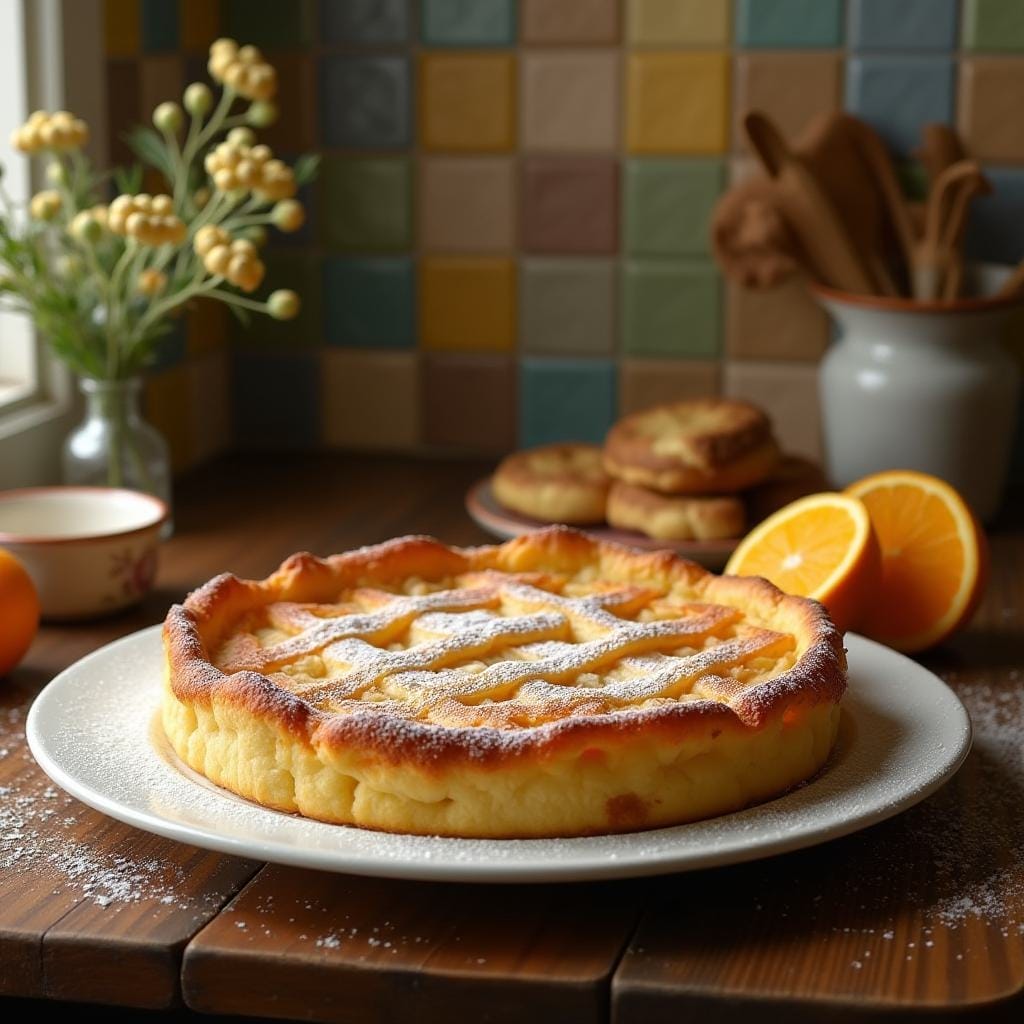Jump to Recipe
As spring arrives, the delicious smell of a real Pastiera Napoletana fills my kitchen, transporting me back to my grandmother’s kitchen in Naples. Usually served as a dessert at Easter, this Italian pastry carries a rich history and evokes cherished memories. Making the dough and mixing the ingredients reminds me of generations-old Neapolitan traditions.
Each step is a reminder of our heritage. Sharing this Pastiera recipe goes beyond giving you a tutorial. It’s a love letter to my roots, and I can’t wait for you to taste this beloved Italian dessert.
The Rich History of Pastiera Napoletana
The Pastiera Napoletana is not just a dessert but a living piece of history, intricately woven into the unique culture of Naples. This famous pastry is an important part of Neapolitan food culture and represents the essence of Italian Easter traditions. Let’s look at its fascinating history:
Treasure of Neapolitan Cuisine
The Pastiera Napoletana’s history dates back to Roman times. In its early forms, people thought that the grains and honey used to make this treat represented springtime and new life. As it changed over time, it became an important part of Naples’ cultural history.
This change demonstrates how local ingredients and traditions have shaped the history of this beloved dessert.
Origins and Traditions
Usually, people make pastry during Holy Week, just before Easter. Each ingredient in Pastiera has a special meaning that relates to nature’s renewal and the start of spring.The cooked wheat stands for wealth and renewal, while the fresh ricotta stands for purity. Making Pastiera, a tradition spanning generations, fosters family closeness and perpetuates cultural traditions, enhancing Italian Easter traditions for future generations.
Essential Ingredients for an Authentic Pastiera
Pay close attention to the details when making a perfect Pastiera Napoletana, especially when choosing the ingredients. Finding the right ingredients is essential if you want this famous Italian dessert to taste and feel like it should.
The Importance of Fresh Ricotta
For your pastries to turn out well, you must use fresh, high-quality ricotta cheese. When mixed with other ingredients, fresh ricotta tastes mild and has a creamy texture.
Fresh ricotta creates a smooth and rich filling that is irresistible. For best results, buy or make fresh ricotta from an Italian deli.
The Flavor of Cooked Wheat
Grano cotto, or cooked wheat, is another important ingredient that gives the Pastiera its unique texture. This portion of the dessert has a great bite and a rustic look. Gourmet food stores that sell Italian foods carry grano cotto.
You can also make it at home by cooking whole wheat berries until they are soft. The cooked wheat blends perfectly with the filling, adding a truly Italian touch that you will never forget.
Using Scented Floral Water
Adding orange blossom water gives the Pastiera a unique floral scent, which makes it taste better. It gives the dessert a light, fragrant sweetness that goes well with all the other tastes.
Other than orange blossom water, you can also use rose water. Every bite of this water, with its wonderful smell, will transport you right to the heart of Naples.

Making Pastiera Napoletana: A Step-by-Step Guide
This baking guide will teach you how to make the best Pastiera Napoletana. If you want to have a memorable traditional baking experience, follow these Italian pastry techniques.
Preparing the Dough
Let’s begin with the recipe for the Pastiera dough. In a bowl, mix together 2 cups of all-purpose flour, 1/2 cup of sugar, and a pinch of salt. It’s time to add the cold, diced butter.
Mix it into the flour mixture until it looks like coarse crumbs. Incorporate two beaten eggs into the dough until it begins to bind together. Prepare a bag and refrigerate for at least an hour.
Creating the Filling
The next step is to make a rich filling. Combine one cup of fresh ricotta, three beaten eggs, and one cup of sugar in a large bowl. Mix until it’s smooth.
Mix in a tablespoon of orange blossom water, a teaspoon of vanilla extract, and half a cup of cooked wheat. Stir everything together until it’s well mixed.
Assembling and baking
It’s now time to put it together and bake it. Warm the oven up to 350°F. On a floured surface, roll out the chilled dough until it is about 1/8 inch thick. Cut off the extra dough and line a 9-inch pie dish with it.
Fill the dish with dough, then pour the filling inside. Cut the rest of the dough into strips after rolling it out. Place the strips on top of the filling in a lattice pattern. Bake it for 60 to 70 minutes, or until the crust turns golden and the filling solidifies.
Before serving your Pastiera Napoletana, allow it to cool completely. Savor the fruits of your traditional baking efforts and gain a genuine understanding of the process of making Italian pastry.

Common mistakes to avoid
It can be enjoyable to bake a perfect Pastiera Napoletana, but it’s important to avoid making common mistakes. Here are some tips for baking that will help you avoid those problems.
Let’s start with the dough. Overworking the dough is one of the most common mistakes people make when making Pastiera Napoletana. Make sure to mix the dough only until it comes together completely. If you work it too hard, it can become tough instead of soft.
Next, the amounts of the ingredients. Measurements must be right when baking. If you make a mistake in this area, it can be easily rectified to solve dessert problems. Always weigh the ingredients, especially the flour, to avoid getting a texture you don’t want.
Underbaking is another common mistake. The pâteiera requires a precise baking time to set properly. Be sure to carefully follow the suggested time, because if you cook it for too little time, the middle will be runny, which is not enjoyable.
Keeping the dessert in the right way is also very important for maintaining its flavor. Once it’s cool, put your Pastiera Napoletana in a container that won’t let air in. This preserves the pastry’s aroma and prevents it from drying out.
If you want to make the perfect Pastiera Napoletana, follow these simple pastry tips. Always keep in mind that when you bake, patience and accuracy are your best friends.

Pastiera Napoletana
Ingredients
Method
- Prepare the Dough:
- In a bowl, combine the flour, sugar, and a pinch of salt. Add the cold, diced butter and mix until the mixture resembles coarse crumbs.
- Stir in the beaten eggs and mix until the dough comes together. Wrap the dough in plastic wrap and refrigerate for at least an hour.
- Make the Filling:
- In a large bowl, combine the fresh ricotta, beaten eggs, and sugar. Mix until smooth.
- Add the orange blossom water, vanilla extract, and cooked wheat. Stir well to combine.
- Assemble and Bake:
- Preheat your oven to 350°F (175°C).
- Roll out the chilled dough on a floured surface until it’s about 1/8 inch thick. Line a 9-inch pie dish with the dough, trimming any excess.
- Pour the filling into the pie crust. Roll out the remaining dough and cut into strips. Arrange the strips in a lattice pattern over the filling.
- Bake for 60–70 minutes or until the crust is golden and the filling is set. Let it cool completely before serving.
Notes
Cooked Wheat: You can find grano cotto in Italian specialty stores or cook whole wheat berries until soft if you can’t find it.
Floral Water: Orange blossom water gives the Pastiera its unique aroma. Rose water is a good substitute if needed.
Tasting and Serving Your Pastiera Napoletana
Take a moment to enjoy the rich textures and flavors of a Pastiera Napoletana in order to fully understand how complex it is. The delicate balance between the smooth ricotta and the fragrant orange blossom water makes for a truly unforgettable Italian dessert experience. Let the complex flavors shine through by serving each slice at room temperature.
Think about what drinks you’ll serve with your pastries. A strong Italian espresso shot can go really well with the sweet and creamy notes. If you want to treat yourself a little, a glass of sweet dessert wine like Moscato d’Asti or Vin Santo can really take your food pairing to the next level.
It’s not necessary to go all out when serving desserts like Pastiera Napoletana at events; a little work goes a long way. For a touch of class, lightly dust the top with powdered sugar. Putting it on a traditional ceramic platter can make it look more Italian. The taste and presentation will please your guests.
FAQ
What is Pastiera Napoletana’s origin?
The recipe for Pastiera Napoletana goes back to Roman times and has become a beloved tradition in Naples, Italy. This dessert represents nature’s renewal for Easter, and it’s a must-have in the spring.
Why is Pastiera such a special Easter dessert?
Pastiera holds a special place in spring celebrations because it reminds people of how nature grows again. When you mix the ingredients, like cooked wheat and fresh ricotta, they make a flavor that tastes like the new life that comes with spring.
Which ingredients are essential for an authentic Pastiera?
Fresh ricotta cheese, cooked wheat (grano cotto), and scented floral water like orange blossom or rose water are all necessary. These ingredients give the dessert its unique texture and fragrant taste.
How does fresh ricotta affect the Pastiera?
It is important to use fresh, high-quality ricotta because it gives the filling a smooth, creamy texture. Also, the taste will be deeper and more real than if you used regular or processed ricotta.
What’s the role of cooked wheat in pasta?
Pastiera’s unique texture comes from cooked wheat, also known as grano cotto. It’s a special ingredient that makes this Italian pastry different from other desserts; it gives it a little chewiness and makes it taste better overall.
How do you achieve the perfect floral aroma in pastries?
Adding orange blossom or rose water to the Pastiera gives it soft floral notes. This fragrant infusion enhances the overall taste, making every bite a sensory delight.
What are the key steps to making Pastiera Napoletana?
To make it, you need to make a crumbly, buttery pastry dough, mix ricotta with eggs and sugar to make a rich filling, and then carefully put the layers together and bake them until they turn golden.
How can I avoid common mistakes when making Pastiera?
People often make mistakes, such as working the dough too much or not baking the pastry long enough. Follow exact measurements for the ingredients, keep the oven at the right temperature, and store the dessert in the right way to keep it fresh.
What’s the best way to serve and enjoy Pastiera Napoletana?
To get the most out of Pastiera, serve it a little chilled so the flavors can mix. To bring out its rich, floral notes, drink it with an Italian espresso or a sweet dessert wine. When it’s for a gathering, presenting it beautifully can make the meal a lot better.
